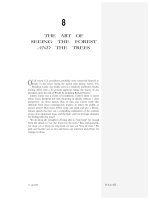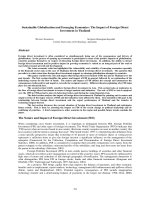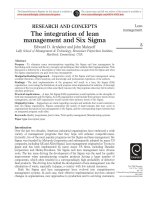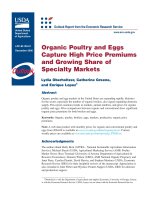aggregate supply, the price level, and the speed of adjustment
Bạn đang xem bản rút gọn của tài liệu. Xem và tải ngay bản đầy đủ của tài liệu tại đây (184.26 KB, 18 trang )
Chapter 26
Aggregate supply, the price level, and
the speed of adjustment
David Begg, Stanley Fischer and Rudiger Dornbusch, Economics,
6th Edition, McGraw-Hill, 2000
Power Point presentation by Peter Smith
26.1
Introducing prices and the labour market
In discussing equilibrium within the
IS-LM model, it has been assumed
that
– prices are fixed
– the supply-side of the economy can be
ignored.
These assumptions must now be
relaxed.
26.2
The price level and aggregate demand
The CLASSICAL model of
macroeconomics analyses the economy
when wages and prices are fully flexible.
The real money supply is the key variable
linking the aggregate demand for goods
and the price level.
The price level is the average price of all
the goods produced in the economy.
26.3
The macroeconomic demand
schedule (MDS) connects
these points
MDS
The macroeconomic demand schedule
Real money supply is nominal
money supply divided by the
price level – it influences the
position of LM.
Income
Income
r
P
IS
LM
0
Y
0
P
0
With price at P
0
, LM is located
at LM
0
, and given IS, real
income is in equilibrium at Y
0
.
At a lower price P
1
, LM is at
LM
1
, and real income at Y
1
.
LM
1
Y
1
P
1
26.4
MDS
The macroeconomic demand schedule
Income
Income
r
P
IS
0
LM
0
Y
0
P
0
LM
1
Y
1
P
1
The MDS shows the different
combinations of the price level
and real income at which
planned spending equals
actual output once interest
rates are set to keep money
market equilibrium.
Notice that a fall in price may
also shift IS by increasing the
value of household wealth via
the real balance effect.
IS
1
Y
2
The effect of this is to produce
a flatter schedule MDS'.
MDS'
26.5
The labour market and aggregate supply
The aggregate supply schedule
– shows the output that firms wish to
supply at each price level.
Given that output depends on inputs
employed, the labour market is the
starting point for analysing
aggregate supply.
26.6
The labour market
Employment,
labour force
Real wage
LD
LD is the labour demand
schedule: it shows how
much labour firms demand
at each real wage.
LF
The schedule LF shows
that more people will be in
the labour force at higher
values of the real wage.
AJ
AJ shows how many
workers have accepted
jobs at each real wage.
N*
N
2
Equilibrium is where AJ = LD, at N*.
N
2
– N* is the natural rate of unemployment.
w*
26.7
The labour market
Employment,
labour force
Real wage
LD
LF
AJ
N*
N
2
w*
The unemployment that
occurs in equilibrium
(shown by N
2
– N*) is
voluntary.
If the real wage is above its
equilibrium at w
1
, there is
unemployment given by
N
3
– N
1
.
N
3
N
1
w
1
Of this, BC is voluntary,
but AB is involuntary.
A B
C
26.8
The aggregate supply schedule
Output
Flexibility of wages and
prices ensures that real
wage adjustment maintains
full employment in the
labour market.
So overall equilibrium is shown where MDS = AS
at the potential output level Y
p
and price level P.
MDS
P
In the CLASSICAL model,
with no money illusion and
flexible money wages, AS
is vertical at the level of
potential output.
AS
Y
p
26.9
Monetary and fiscal policy
Output
MDS
P
0
AS
Y
p
Changes in nominal money
supply or in fiscal policy
shift the MDS, altering the
level of aggregate demand
at each price.
In the Classical model, a change in nominal money supply
leads to an equivalent % change in nominal wages & prices.
Real money supply, interest rates, output, employment
and real wages ALL remain unchanged.
E
But a shift from MDS to MDS'
alters equilibrium from E to E';
price increases from P
0
to P'
but output remains at Y
p
.
MDS'
P'
E'
26.10
Fiscal policy
An increase in government expenditure in
this model
– bids up prices
– so real money supply is lower
– interest rates rise
– private expenditure on consumption and
investment falls
– i.e. there is complete crowding out
– all that changes is the composition of
aggregate demand
– the public sector becomes more important.
26.11
The speed of adjustment
Adjustment in the Classical world is rapid,
so the economy is always at potential
output (full employment).
If wages and prices are sluggish, then
output may deviate from the potential
level.
A "Keynesian" world of fixed wages and
prices may describe the short run period
before adjustment is complete.
26.12
Supply-side economics
The pursuit of policies aimed not at
increasing aggregate demand, but at
increasing aggregate supply.
A way of influencing potential output,
seen as critical in the Classical view
of the economy.
26.13
Adjustment in the labour market
Short-run
(3 months)
Medium run
(1 year)
Long-run
(4-6 years)
WAGES
HOURS
EMPLOYMENT
Largely
given
Demand-
determined
Largely
given
Beginning
to adjust
Hours/
employment
mix
adjusting
Clearing
the labour
market
Normal
work week
Full
employment
26.14
Short-run aggregate supply
If adjustment is not instantaneous, output
may diverge from Y
p
in the short run.
Firms may vary labour input
– via hours of work (overtime or layoffs)
Wages may be sluggish in falling to
restore full employment in response to a
fall in aggregate demand
The short-run aggregate supply schedule
shows the prices charged by firms at each
output level, given the wages they pay.
26.15
The short-run aggregate supply schedule
Output
Y
p
SAS
P
0
SAS
1
SAS
2
In time, the firm is able to
negotiate lower wages,
and the SAS shifts to
SAS
1
and then to SAS
2
,
A
A
2
P
2
until equilibrium is
restored at A
2
.
Suppose the economy is initially at Y
p
in full-
employment equilibrium at A, with price P
0
B
In response to a fall in
aggregate demand,
firms in the short run
vary labour input, thus
moving along SAS to B.
26.16
MDS'
a fall in nominal money
supply shifts MDS to MDS'
Output
Y
p
SAS
P
E
MDS
AS
A fall in nominal money supply
Starting from long-run
equilibrium at E:
E'
P'
Given wage levels, firms
adjust to E' in the short run
With price at P' but wages
unchanged, the real wage
rises bringing involuntary
unemployment.
P
3
SAS
3
E
3
Equilibrium is eventually reached at E
3
, back at Y
p
.
SAS'
As the labour market (wage)
adjusts SAS shifts e.g. to SAS'
P''
26.17
An adverse supply shock:
e.g. an increase in the price of oil
Y
p
'
MDS
Output
P
P
SAS
E
SAS'
Higher oil prices force
firms to charge more
for their output, so SAS
shifts to SAS'
Y'
Higher prices cause a
move along MDS, and
output falls to Y'
P'
E'
equilibrium from E to E'
In time, unemployment
reduces wages and SAS
gradually shifts back to
SAS, so Y
p
is restored.









